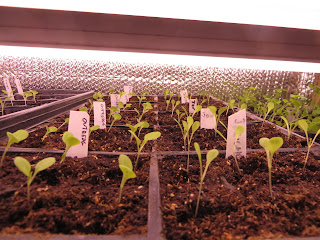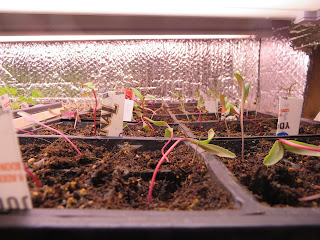 We have room for 3 and a half full sized shares.
We have room for 3 and a half full sized shares. I need to know very soon if you are interested so I know how much to plant for our first delivery day on May 31.
I have added a limited area in Westboro to my Tuesday delivery route. If you are in the vicinity of Princeton avenue, I can include your address.
Hey everyone:
Work has really picked up over the past week. The field was soaked two weeks ago but has dried steadily and now I am well into preparing the beds for the season.
Today, I planted the first round of peas and spinach in the field. The food is on the way!
I have yet to do a 'headcount', but the garlic seems to be emerging quite uniformly.
Around here, garlic is typically planted in the late fall and spends the winter dormant, protected by a layer of straw mulch.
As the days begin to warm, I start pulling the straw back for the day to warm up the beds. This seems to encourage earlier growth. I compared my results with a neighboring grower last year and found I was harvesting garlic two weeks earlier than they were, and the removal of the straw seems to be the differing factor.
 If the straw were left on, the garlic would push up through, though the growth would be a bit slower. I need that extra two weeks as late season cabbage typically follows the garlic.
If the straw were left on, the garlic would push up through, though the growth would be a bit slower. I need that extra two weeks as late season cabbage typically follows the garlic. The straw goes back onto the beds for the night. This acts a s a blanket upon the bed, holding the days warmth inside.
Garlic can probably withstand the nightly lows of minus four to zero that we have been getting out here, but I would rather have it concentrate it's growth energy on thriving as opposed to surviving.
 I need all the time I can get. At this time of year, everything is gearing up to grow as quickly as possible. So as I clean one bed, 128 other beds are starting to sprout weeds.
I need all the time I can get. At this time of year, everything is gearing up to grow as quickly as possible. So as I clean one bed, 128 other beds are starting to sprout weeds.To give me some extra time, I place Infrared transmitting mulch (IRT mulch) on beds that are yet to be cleaned up, usually beds that are not required for the next couple of weeks.
IRT mulch allows the heat of the sun to pass through to the ground and then hold the heat in at night. However, the mulch blocks the white light that allow plants to grow.
Some growers leave their mulch on all season, and plant their seedlings (typically peppers and tomatoes) right through the mulch. They do this to prevent weed growth and supposedly this interferes with bugs as well.
My preference is to take the mulch off at planting time. The mulch eventually degrades in sunlight and is expensive to replace. (some non-organic growers allow it to break down into the soil!)
As well, I need all the frogs and toads I can get to eat flea beetles and aphids; trapping them under a layer of plastic won't help them at all.
I do have to check once in a while to ensure this is not happening...
Like row covers, one of the biggest drawbacks is that IRT mulch is ugly looking.
 The outdoor nursery is half full, and doing a decent job of keeping the cold tolerant plants warm at night.
The outdoor nursery is half full, and doing a decent job of keeping the cold tolerant plants warm at night.For lettuces, onions, parsley, and kale, plus five degrees is tolerable.
By day, all plants come out from the nursery and take a spot in the sun. The nursery can get quite warm, but plenty of shade and indirect light is built in to protect the youngest plants from cooking.
Heat is augmented at night by a few large patio stones that are set in the sun all day. These re-radiate the suns heat at night and moderate the interior temperature.
I hope to write more soon, though realistically, it may be another two weeks before I can write. In the meantime, start swotting your cookbooks for recipes that include spinach, arugula, garlic greens, lettuce and peas!
Bob








